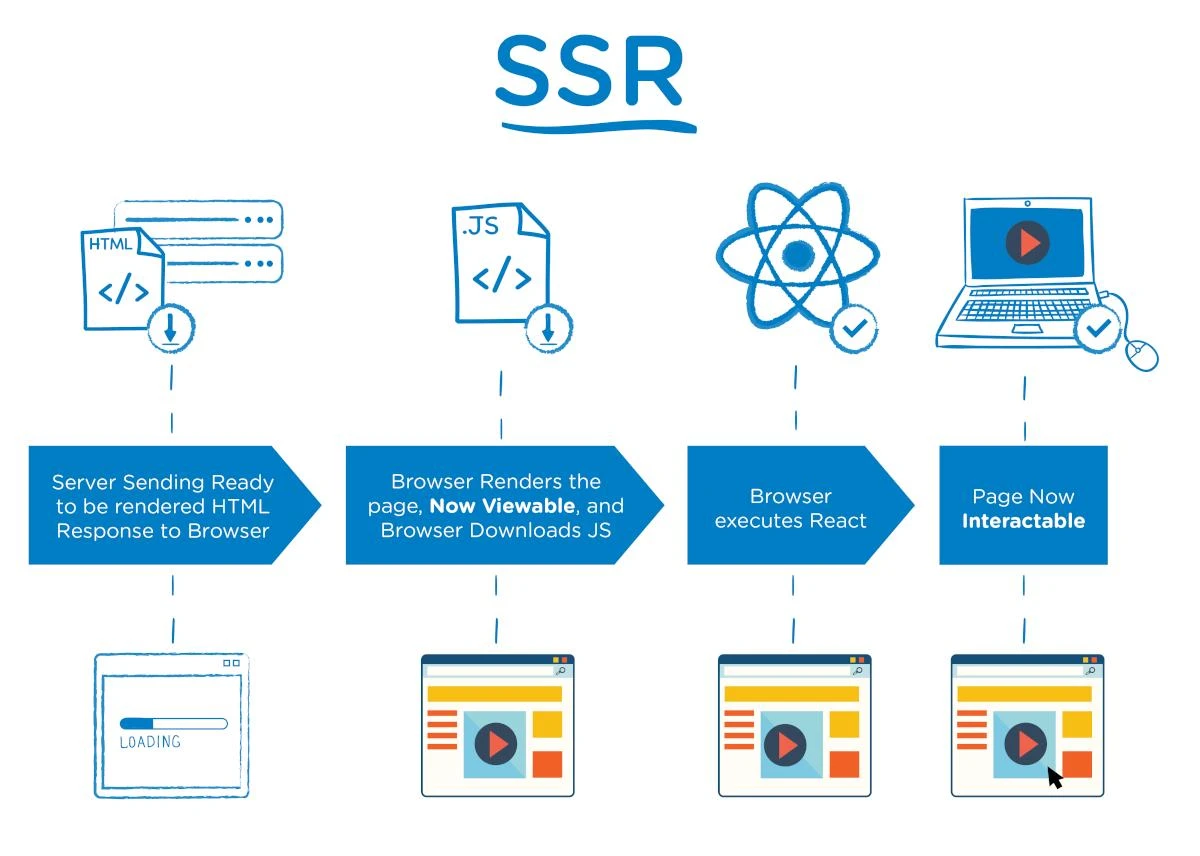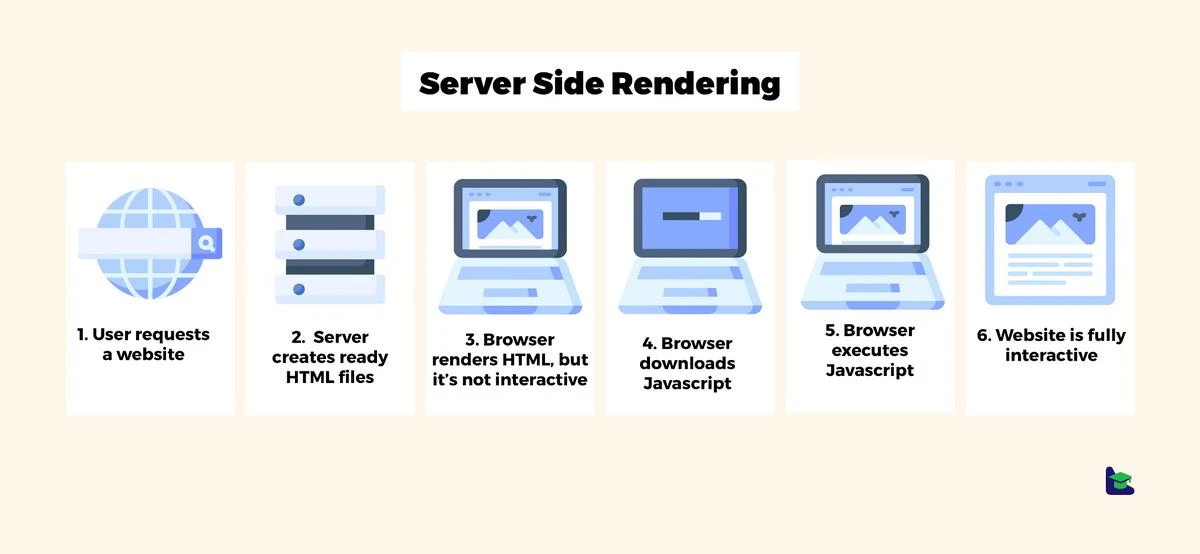ReactJS is a popular JavaScript library that enables developers to create dynamic and interactive user interfaces. It is widely used for building web applications, especially those that require real-time updates and seamless performance. When it comes to developing a high-performance web application, one crucial aspect that cannot be ignored is server-side rendering (SSR). However, for server-side rendering you might need to hire a react developer.
In this article we’ll discuss the meaning of server-side rendering, how it works, why it matters and what are the benefits of server-side rendering.
Let’s begin!
What is Server-Side Rendering?
Server-side rendering (SSR) is a technique used to pre-render web pages on the server-side and serve them to the client-side as fully-formed HTML pages. In simple terms, SSR generates HTML pages with all the content and assets loaded, and sends them to the client's browser to render. This is in contrast to client-side rendering, where the HTML is generated by JavaScript after the page is loaded, causing slower load times, poor SEO, and a lack of support for users with JavaScript disabled.
In React, SSR involves rendering the initial HTML markup on the server-side and then passing it to the client-side JavaScript, which takes over the rendering and interactivity. This approach allows for faster page load times, better search engine optimization, and improved user experience.
How Server-side Rendering (SSR) Works?
Server-side rendering (SSR) is a process of rendering a web page on the server and sending the fully rendered HTML to the client's browser instead of sending a blank page that needs to be populated with JavaScript. SSR is a crucial feature for web applications because it can significantly improve the performance, user experience, and search engine optimization (SEO) of the application.

Source: As Per Brother
To implement SSR, developers need to create a server-side environment that can execute JavaScript code and generate HTML pages dynamically. The server-side environment can be built using Node.js, PHP, Ruby, or other server-side technologies that can handle HTTP requests and responses.
The process of SSR involves the following steps:
-
The client sends an HTTP request to the server for a particular web page.
-
The server receives the request and starts processing it.
-
The server fetches the required data from the database or other sources.
-
The server generates an HTML template using the fetched data and the application's logic.
-
The server replaces the placeholders in the template with the dynamic content.
-
The server sends the fully rendered HTML to the client's browser as an HTTP response.
-
The client's browser receives the HTML and displays it to the user.
Why Does Server-Side Rendering Matter?
Server-side rendering has become increasingly important in recent years due to the rise of single-page applications (SPAs). SPAs are great for delivering a fast and smooth user experience, but they can also have some drawbacks. SPAs rely on JavaScript to render the UI, which can be slow to load on slow networks or older devices.
Moreover, search engines have a hard time crawling SPAs because they rely heavily on JavaScript. This means that SPAs may not rank as high in search engine results pages (SERPs) as traditional websites that use server-side rendering.
Benefits of Server-Side Rendering in React
React is a popular JavaScript library used for building user interfaces. In this section, we will discuss the benefits of server-side rendering in React and how it can be helpful to hire React developers.
Improved Performance
Server-side rendering helps in improving the performance of web applications. When you render your React application on the server-side, the initial load time of the page is reduced. This is because the HTML code is generated on the server-side and sent to the client-side for display. This results in faster load times and improved performance.
Better SEO
Search engines crawl the HTML code of a web page to understand its content. If your web application is purely client-side rendered, the search engine may not be able to crawl it effectively. This can negatively impact your SEO. However, if you use server-side rendering, the search engine can crawl the HTML code generated on the server-side. This can result in better SEO and improved visibility of your web application.
Accessibility
Server-side rendering can improve the accessibility of your web application. People with disabilities may use screen readers to access your web application. If your web application is client-side rendered, the screen reader may not be able to access the content effectively. However, with server-side rendering, the HTML code generated on the server-side is accessible to the screen reader. This can improve the accessibility of your web application.

Source: Droptica
Improved User Experience
Server-side rendering can help in improving the user experience of your web application. When a user visits your web application, they expect a fast and seamless experience. With server-side rendering, the initial load time of the page is reduced, resulting in a faster user experience. This can result in better engagement and increased user satisfaction.
Improved Time to First Byte (TTFB)
Time to First Byte (TTFB) is the time taken by the server to respond to a user's request. This is an essential metric for measuring the performance of your web application. With server-side rendering, the TTFB is reduced, resulting in faster response times. This can improve the overall performance of your web application.
Better Security
Server-side rendering can improve the security of your web application. When you render your application on the client-side, the client-side JavaScript code is visible to anyone who accesses the web application. This can make it vulnerable to attacks. However, with server-side rendering, the JavaScript code is not visible to the client-side, making it more secure.
Improved Caching
Caching can improve the performance of your web application by reducing the number of requests to the server. With server-side rendering, you can take advantage of caching on the server-side. This can improve the performance of your web application and reduce the load on the server.
Easier Debugging
Debugging client-side JavaScript code can be challenging. However, with server-side rendering, you can easily debug the code on the server-side. This can make it easier to identify and fix issues with your web application.
Conclusion
In conclusion, server-side rendering is an essential technique for improving the performance, SEO, and accessibility of React applications. By hiring a React developer who is proficient in SSR, businesses can ensure that their web applications are fast, reliable, and accessible to all users. With the increasing demand for fast and responsive web applications, server-side rendering is becoming an essential skill for React developers to master.


No comments yet